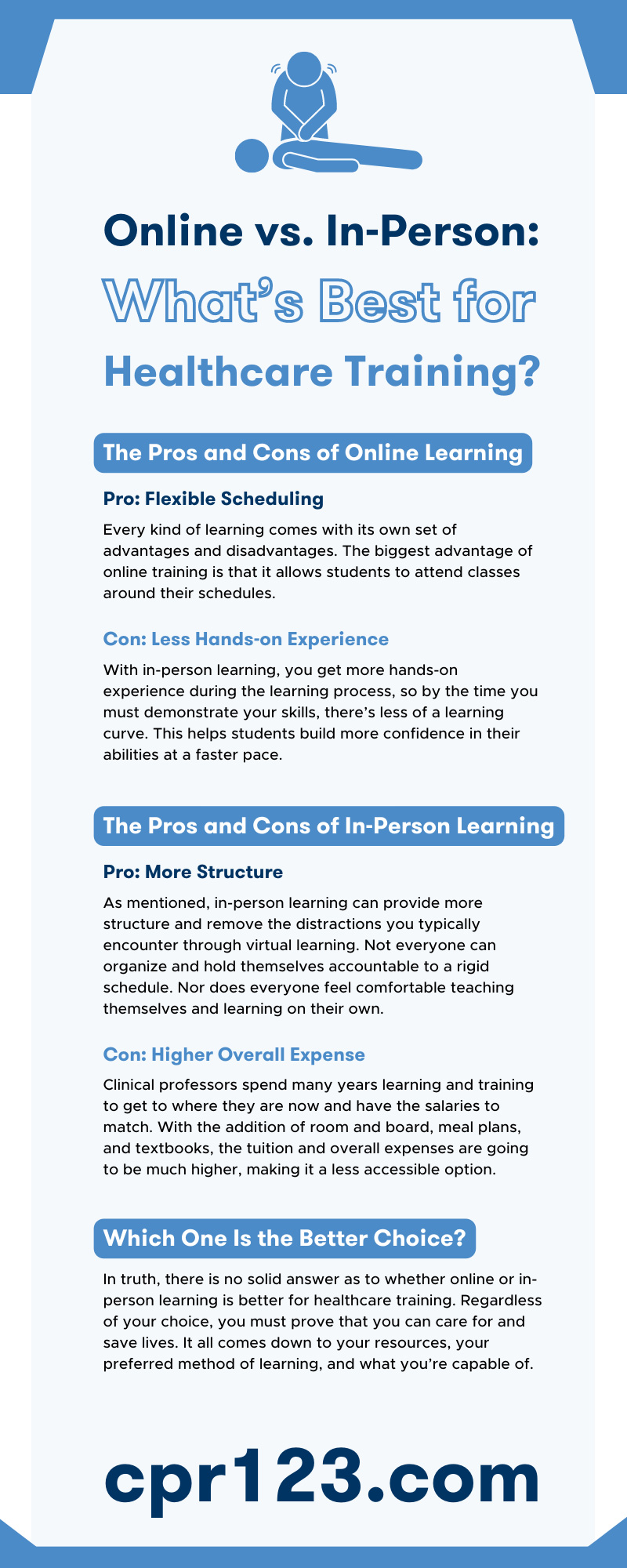As medical science advances and treatments improve, so does life expectancy. With people only getting older and hospitals being shorter-staffed, the demand for quality medical care and trained medical professionals is increasing. Now more than ever, we need to make medical training accessible to those willing to invest time and effort into becoming nurses and practitioners. Online learning seems to be the solution, but some aren’t convinced that online medical training can produce competent medical personnel. This begs the question, what is best for the future of healthcare training, online or in-person learning?
What’s the Difference Between In-person and Online Learning?
Online and in-person learning are relatively new terms and concepts that arose during the beginning of the COVID-19 pandemic. Traditional forms of learning involved sitting in a classroom with other students, learning the same thing at the same pace for many years. This well-established form of education is what’s known as in-person learning. While online courses were conducted well before COVID-19, many are still unfamiliar with its meaning. Online learning simply involves learning in a virtual environment—it does NOT inherently mean that students will refine and practice their new skills online.
What About Hybrid Learning?
Hybrid, or blended learning, is when teachers bring online and in-person education materials together to complement their teaching style and provide different learning opportunities for their students. Many online learning medical programs offer some form of in-person learning and require students to come in for labs or hands-on training. If an online course does not offer this, they will still likely have you come into their office at some point and demonstrate the skills you’ve learned.
The Pros and Cons of Online Learning
Pro: Flexible Scheduling
Every kind of learning comes with its own set of advantages and disadvantages. The biggest advantage of online training is that it allows students to attend classes around their schedules. They can still go to work and make a living while going to school. Some managers understand how intense schooling can be and will allow students to take as little as one or two shifts a week.
Pro: Learning at Your Own Pace
Even if an in-person class works with your schedule, you may be unable to keep up with the pace the teacher or other students set. With online learning, you can take things slow, learn at your own pace, and feel less pressure to keep up with others.
Pro: Price Accessibility
Many online courses don’t require a teacher to be present 24/7, cutting the program’s overall cost. Additionally, students don’t need to pay for housing or spend exorbitant amounts of money on gas to commute from home to school and back. Online learning makes education accessible to those that previously didn’t have the opportunity.
Con: Less Hands-on Experience
With in-person learning, you get more hands-on experience during the learning process, so by the time you must demonstrate your skills, there’s less of a learning curve. This helps students build more confidence in their abilities at a faster pace.
Con: Distractions and Technical Issues
Not everyone learns the same, and some prefer the rigidity of a classroom, as learning from home can lead to various distractions and temptations. Not everyone has the luxury of a quiet home office free of distractions. Additionally, technical issues are inevitable, which can be frustrating when you’re working under deadlines.
Con: Online Fatigue
Spending extended amounts of time online can be tiring for many and can affect their social engagement. It can leave people feeling worn out and even isolated if the majority of their human interaction occurs online or they’re constantly in meetings.
The Pros and Cons of In-Person Learning
Pro: More Structure
As mentioned, in-person learning can provide more structure and remove the distractions you typically encounter through virtual learning. Not everyone can organize and hold themselves accountable to a rigid schedule. Nor does everyone feel comfortable teaching themselves and learning on their own.
Pro: Increase in Active Involvement
Being an active participant is a requirement for many in-person programs if you want to pass the class. This forces students to participate. This level of engagement may be useful for some students who need an extra push to stay involved.
Pro: Chance To Build Connections
Many medical professionals, new and experienced, rely on their peers to help them in tough situations and provide a different perspective. While not impossible, it becomes more difficult to make these connections with online learning. This difficulty is especially true for those looking to advance their careers in more niche medical fields.
Con: Higher Overall Expense
Clinical professors spend many years learning and training to get to where they are now and have the salaries to match. With the addition of room and board, meal plans, and textbooks, the tuition and overall expenses are going to be much higher, making it a less accessible option.
Con: More Time Consuming
Not only is it more difficult to work around in-person classes, but they often consume more time. Online students can learn when and where they want and can pause if necessary. If you’re in an in-person class, you may be stuck in one spot for hours at a time.
Con: Less Adaptable To Learning Styles
In the same way that some need the strict rigidity of a classroom, others don’t and can’t benefit from it. Traditional face-to-face learning doesn’t have the same adaptability as online learning, especially for those with different learning styles. Those that learn at home can adapt the course to suit their learning style.
Which One Is the Better Choice?
In truth, there is no solid answer as to whether online or in-person learning is better for healthcare training. Regardless of your choice, you must prove that you can care for and save lives. It all comes down to your resources, your preferred method of learning, and what you’re capable of. In fact, some online students would argue that they must meet higher standards and requirements due to the nature of online medical training. You can still become an incredibly competent medical professional with online healthcare courses.
If you’re ready to take the leap and join the thousands of students engaging in online medical training, work with CPR123. We offer AHA-aligned training courses in basic life support, advanced cardiovascular life support, pediatric advanced life support, and more. We’re ready to help you take your education into your own hands, refine your skills, and become a healthcare professional that makes a difference in the world.








